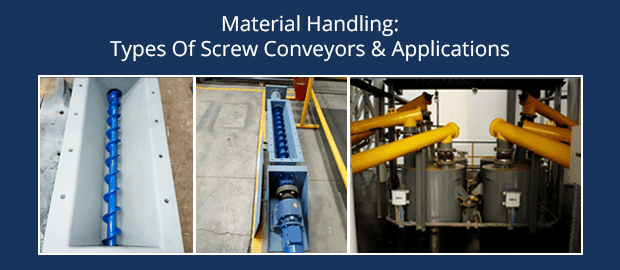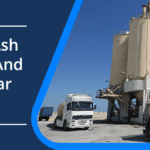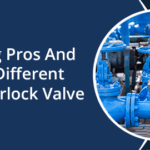A screw conveyor or auger is an industrial piece of equipment that is used to transfer a hefty quantity of granular solids, semi-solids, liquids, and even non-flowing items from one location to another. They maintain high operational efficiency by eliminating the need for employees to physically move materials. Screw conveyors are made to revolve around a screw shaft placed within a trough. It helps move the material vertically as the screw shaft revolves.
The screw conveyor design is quite versatile. The screw conveyor can be designed in a vertical, horizontal, or inclined setup, making them adaptable to various settings. In addition to conveying semi-solid items like food waste, wood chips, aggregates, and animal feed, they can also handle municipal solid waste and boiler ash. Furthermore, they are often utilised in pneumatic conveying systems manufacturer.
Discover the Perfect Screw Conveyor for Your Industry
A] What Are The Different Types Of Screw Conveyors?
1. Horizontal Screw Conveyor:
Horizontal screw conveyors are the most popular type of screw conveyor. Depending on the peculiar characteristics of the material, it is designed to carry bulk materials. They are designed to have a trough loading of 15 – 45%, making them ideal for moving bulk material between process points. A viscous, slow material necessitates a lower trough load, whereas a lighter, free-flowing quantity can be supplied at a maximum load.
2. Inclined Screw Conveyor:
Inclined screw conveyors provide an inclined path for transferring bulk materials to or from an elevated surface, eliminating the need for additional conveying equipment. The angle of inclination can range from 0 to 45 degrees above the horizontal, but as the angle increases, the efficiency and load capacity of the conveyor decreases. This is because the gravitational attraction and fallback of the bulk material require more power to maintain the conveyor’s operation.
If no intermediary hangers are required, the capacity of an inclined screw conveyor can be improved across short distances. These inclined screw conveyors are frequently used in feedlot dispensers, cement mixers, and processes requiring sugar and meat.
3. Shaftless Screw Conveyor:
The shaftless screw conveyor is a screw conveyor type that is also called the “ribbon screw conveyor.” It doesn’t have a middle pipe, the absence of which makes it more efficient, flexible, and able to handle a wider range of materials like industrial sludges and biosolids. It has a spiral shape that allows for faster filling and less wear and tear.
Shaftless conveyors can transport materials such as Grit, industrial sludge, dewatered municipal sludge, wastewater screens, and other stringy materials, eliminating the need for internal bearings in traditional designs. In order to avoid material spilling out of the screw conveyor and to control any unpleasant smells that may be emitted from the materials being conveyed, the screw conveyor can be enclosed or covered.
4. Vertical Screw Conveyor:
As the name implies, vertical screw conveyors transport bulk materials on vertical paths and are capable of inclining at an angle greater than 45 degrees. It is the most cost-effective and space-saving method for moving powders or granular materials from one level to another. The vertical screw can discharge bulk material withdrawn from a silo hopper, conveying it into one or more bins or silos.
Also, it enables the vertical conveyor to run constantly, improving efficiency and gradually reducing power usage. Wastewater facilities, wood production, mining operations, chemical Industries and food Industries are some of the industries where vertical screw conveyors are commonly found.
5. Live Bottom Screw Conveyor:
Live bottom screw conveyors are in charge of monitoring the quantity of material collected from bins, hoppers, and bag dump stations. Several parallel screws are used in the live bottom conveyor to manage the vast amount of material that is often packed under pressure. This ensures that material is discharged equally, even when it comes in on a conveyor at varying densities and sizes.
They are frequently placed under large bins to allow material to flow into a covered trough and be carried by multiple augers. Stepped tapered-pitch or variable-pitch screws are used to accommodate variations in bulk quantity at the inlet. It can be used as a screw feeder for any other screw conveyor.
B] Advantages of Screw Conveyors
- Screw conveyors can handle a variety of materials, from slow to free-flowing, and they are highly compact and adaptable to congested areas.
- When necessary, it can discharge materials at different points since it has a number of inlets and discharge terminals. With the help of a side gate or valve, one can also control the flow of material.
- Screw conveyors can be designed to be vapour-tight or to maintain constant internal pressure, which is critical when conveying toxic or hazardous materials, such as those used in the chemical industry.
- Screw conveyors can also be used to cool, heat, or dry products during transit. Depending on the heat transfer requirement, a screw conveyor can be jacketed, or a hollow-flight design can be utilised to provide the necessary heat transfer for application.
- Screw conveyors can be used for mixing various products and breaking up large lumps.
- Screw conveyors have the capability to accurately control the flow rate of materials from a bin or hopper, making them an ideal choice for starting the material handling process.
- Screw conveyors can serve as an airlock between upstream and downstream machinery.
- A screw conveyor can also be used as a screw feeder if required.
Discover the Perfect Screw Conveyor for Your Industry
C] Workings of Screw Conveyor
Screw conveyors are bulk material pathways with good flow ability and can handle a wide range of materials. This characteristic is essential for the operation of screw conveyors because the rotating screw helix, which is mounted on a central pipeline or shaft, pushes material along the bottom and sides of the tube or trough while sharing it in the radial space between the helix and the tube. This causes the moving face of the helical flight to lift the material while the material tumbles upon itself.
D] Screw Conveyor Uses Across Industries
Listed below are some of the Industries that benefit a lot as a result of the numerous screw conveyor applications:
- Chemicals Industry: To handle and transport hazardous materials safely and efficiently.
- Agriculture Industry: To transport grains, seeds, and other agricultural products.
- Power Plants Industry: To transport coal, ash, and other materials in power plants.
- Grain Handling Industry: To move and distribute grains and other food products in processing plants and storage facilities.
- Minerals and Mining Industry: To transport minerals, ores, and other materials in mining and mineral processing plants.
- Iron and Steel Industry: To transport raw materials, like iron ore and coke, and finished products, like steel, in iron and steel manufacturing plants.
- Dust Collection Systems Industry: To transport dust and other airborne materials in dust collection systems.
- Food Processing Industry: To transport food products and ingredients in food processing plants.
- Woodworking Industry: To transport sawdust, wood chips, and other materials in woodworking plants.
- Oil and Gas Extraction Processing Industry: To transport materials like drilling mud and cuttings in oil and gas extraction and processing plants.
E] Factors to Consider Before Purchasing Screw Conveyors
1. Check the screw conveyor capacity
By calculating the required cubic feet per hour, the required conveyor trough loading percentage, the suitable screw diameter, and the conveyor drive RPM, you may calculate the required volume per hour.
2. Design and placement of screws
Choose the screw design based on the purpose of the screw conveyor. The screw design is very important to the drive because enough horsepower is required to pull material through the auger. Defining the correct drive for the given screw shape will help ensure proper operation
3. Trough Design, Trough Load and Type Of Load
The trough design, trough load, and type of load are some of the most important factors to consider while purchasing screw conveyors. The trough design should be chosen based on the characteristics of the material being conveyed. The Trough load should be carefully calculated to ensure the conveyor can handle the weight of the material. Additionally, the type of load, whether it is a uniform load or a concentrated load, will impact the selection of the screw conveyor.
4. Operating cycle
The operating cycle is yet another crucial factor to take into account when selecting a screw conveyor. For instance, if the screw conveyor runs for two hours, a light structure is suitable. The one that is used continuously, however, needs extensive installation. Keep in mind that the operating cycle affects the drive sizes and material thickness.
Discover the Perfect Screw Conveyor for Your Industry
F] Conclusion
To ensure you select the most suitable screw conveyor for your industry, it’s important to consider the type of material being handled. If you’re still uncertain about your decision and have a few questions as to what would be the right choice for your business’s needs then you should seek advice from experts like our team at Macawber who have extensive knowledge in this field.
As the top screw feeders manufacturer in India, we are committed to providing the best service and ensuring you make an informed decision for your needs. So, do not hesitate to contact us if you need any help in your decision regarding the purchase of screw conveyors and feeders.



